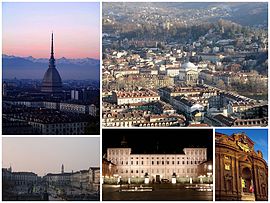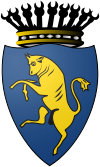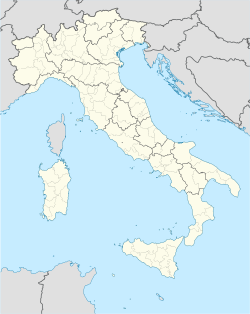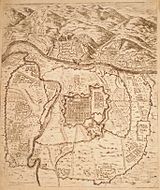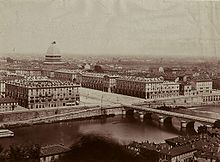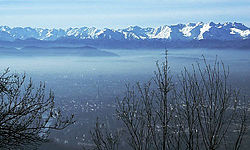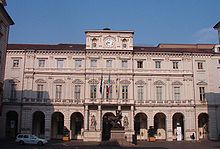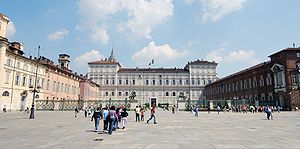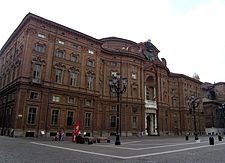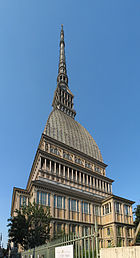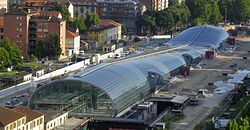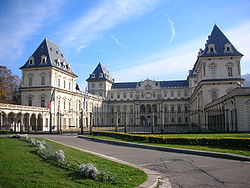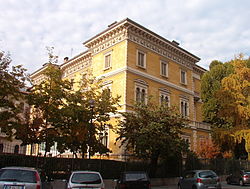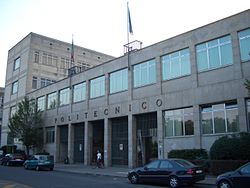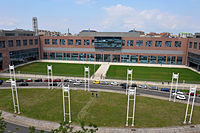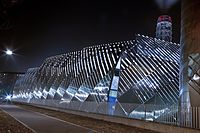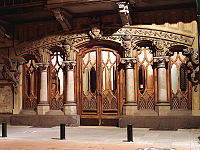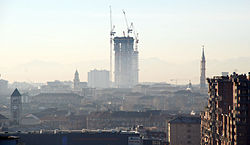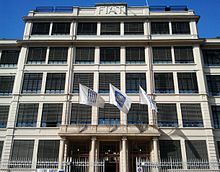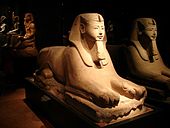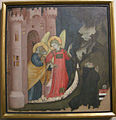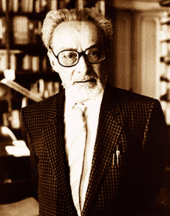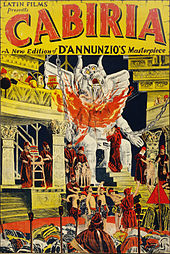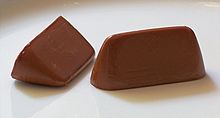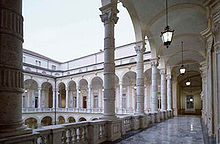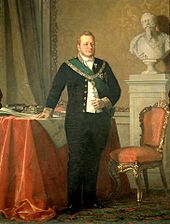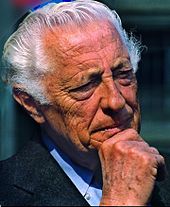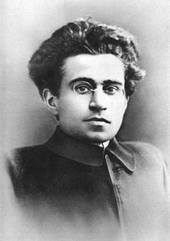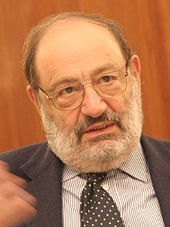
Turin
Background to the schools Wikipedia
This Schools selection was originally chosen by SOS Children for schools in the developing world without internet access. It is available as a intranet download. To compare sponsorship charities this is the best sponsorship link.
| Turin Torino |
|||
|---|---|---|---|
| — Comune — | |||
| Città di Torino | |||
| A collage of Turin: in the top left is the Mole Antonelliana, followed by a view of the city under the snow, the Piazza Vittorio Veneto, the Royal Palace of Turin and the Museo del Risorgimento (Palazzo Carignano) | |||
|
|||
|
|
|||
| Coordinates: 45°04′N 07°42′E Coordinates: 45°04′N 07°42′E | |||
| Country | Italy | ||
| Region | Piedmont | ||
| Province | Turin (TO) | ||
| Government | |||
| • Mayor | Piero Fassino ( PD) | ||
| Area | |||
| • Total | 130.17 km2 (50.26 sq mi) | ||
| Elevation | 239 m (784 ft) | ||
| Population (31 dicembre 2012) | |||
| • Total | 911,823 | ||
| • Density | 7,000/km2 (18,000/sq mi) | ||
| Demonym | Torinesi | ||
| Time zone | CET ( UTC+1) | ||
| • Summer ( DST) | CEST ( UTC+2) | ||
| Postal code | 10100, 10121-10156 | ||
| Dialing code | 011 | ||
| Patron saint | John the Baptist | ||
| Saint day | 24 June | ||
| Website | Official website | ||
Turin (Italian: Torino, pronounced [toˈriːno]; Piedmontese: Turin, pronounced [tyˈɾiŋ]; Latin: Augusta Taurinorum) is a city and major business and cultural centre in northern Italy, capital of the Piedmont region, located mainly on the left bank of the Po River, in front of Susa Valley and surrounded by the western Alpine arch. The population of the city proper is 911,823 (December 2012) while the population of the urban area is estimated by Eurostat to be 1.7 million inhabitants. The Turin metropolitan area is estimated by the OECD to have a population of 2.2 million.
The city has a rich culture and history, and is known for its numerous art galleries, restaurants, churches, palaces, opera houses, piazzas, parks, gardens, theatres, libraries, museums and other venues. Turin is well known for its baroque, rococo, neo-classical, and Art Nouveau architecture. Much of the city's public squares, castles, gardens and elegant palazzi such as Palazzo Madama, were built in the 16th and 18th century, after the capital of the Duchy of Savoy (later Kingdom of Sardinia) was moved to Turin from Chambery (nowadays France) as part of the urban expansion.
Turin is sometimes called the "cradle of Italian liberty", for having been the birthplace and home of notable politicians and people who contributed to the Risorgimento, such as Cavour. The city currently hosts some of Italy's best universities, colleges, academies, lycea and gymnasia, such as the six-century-old University of Turin and the Turin Polytechnic. Prestigious and important museums, such as the Museo Egizio and the Mole Antonelliana are also found in the city. Turin's several monuments and sights make it one of the world's top 250 tourist destinations, and the tenth most visited city in Italy in 2008.
The city used to be a major European political centre, being Italy's first capital city in 1861 and being home to the House of Savoy, Italy's royal family. Even though much of its political significance and importance had been lost by World War II, it became a major European crossroad for industry, commerce and trade, and currently is one of Italy's main industrial centres, being part of the famous "industrial triangle", along with Milan and Genoa. Turin is ranked third in Italy, after Milan and Rome, for economic strength. With a GDP of $58 billion, Turin is the world's 78th richest city by purchasing power, and as of 2010 has been ranked by GaWC as a Gamma- world city. Turin is also home to much of the Italian automotive industry.
Turin is well known as the home of the Shroud of Turin, the football teams Juventus F.C. and Torino F.C., the headquarters of automobile manufacturers FIAT, Lancia and Alfa Romeo, and as host of the 2006 Winter Olympics. Several International Space Station modules, such as Harmony and Columbus, were also manufactured in Turin. It was the capital of the Duchy of Savoy from 1563, then of the Kingdom of Sardinia ruled by the Royal House of Savoy and finally the first capital of the unified Italy.
It is often referred to as "the Capital of the Alps". Turin is also known as "the Automobile Capital of Italy" or the Detroit of Italy as it is home of FIAT; in Italy it is also called "[La] capitale Sabauda".
History
Ancient origins
The Taurini were an ancient Celto-Ligurian Alpine people, who occupied the upper valley of the river Po, in the centre of modern Piedmont.
In 218 BC, they were attacked by Hannibal since his allies were the Insubres. The Taurini and the Insubres had a long-standing feud. Their chief town (Taurasia) was captured by Hannibal's forces after a three-day siege. As a people they are rarely mentioned in history. It is believed that a Roman colony was established in 27 BC with the name Castra Taurinorum and afterwards Julia Augusta Taurinorum (modern Turin). Both Livy (v. 34) and Strabo (iv. p. 209) speak of the country of the Taurini as including one of the passes of the Alps, which points to a wider use of the name in earlier times.
The tribe of the Taurini is the origin of the city of Torino: Celtic in origin (most likely from the Austrian halstatt Celtic tribe within which all celts descended from), they joined the ligurian tribes peacefully. The city symbol and coat of arms is the rampant bull - Torino literally means "young bull". The Salassi, another Celtic Italian tribe, was also part of the Piemonte area which was eventually destroyed by the Romans. The language of the Piemonte region, Piemontese, still to this day contains many words of Celtic origin and is more than a dialect: it is indeed a separate language spoken to this day by the people of Torino and the Piemonte region, giving them a unique sense of identity and affinity with their ancient ancestral heritage.
Roman times
In the 1st century BC, probably 28 BC, the Romans created a military camp (Castra Taurinorum), later dedicated to Augustus (Augusta Taurinorum). The typical Roman street grid can still be seen in the modern city, but especially in the neighbourhood known as the Quadrilatero Romano. Via Garibaldi traces the exact path of the Decumanus of the Roman City which began at the Porta Decumani which was later incorporated into the Castello or Palazzo Madama. The Porta Palatina, on the north side of the district is still preserved in a park near the Cathedral. Turin reached about 5,000 inhabitants at the time, all living inside the high walls.
Middle Ages
After the fall of the Roman Empire, the town was conquered by the Lombards, then the Franks of Charlemagne (773). The Contea di Torino (countship) was founded in the 940s, which was held by the Arduinic dynasty until 1050. After the marriage of Adelaide of Susa with Humbert Biancamano's son Otto, the family of the Counts of Savoy gained control. While the dignity of count was held by the Bishop as count of Turin (1092–1130 and 1136–1191) it was ruled as a prince-bishopric by the Bishops. In 1230–1235 it was a lordship under the Marquess of Montferrat, styled Lord of Turin. At the end of the 13th century, when it was annexed to the Duchy of Savoy, the city already had 20,000 inhabitants. Many of the gardens and palaces were built in the 15th century when the city was redesigned. The University of Turin was also founded during this period.
Early modern
Emmanuel Philibert, known with the nickname "Iron Head", made Turin the capital of the Duchy of Savoy in 1563. Piazza Reale, today named Piazza San Carlo and Via Nuova, today called Via Roma were added with the first enlargement of the walls, in the first half of the 17th century; in the same period the Royal palace (Palazzo Reale) was also built. In the second half of that century, a second enlargement of the walls was planned and executed, with the building of the arcaded Via Po, connecting diagonally Piazza Castello with the bridge on the Po through the regular street grid.
In 1706, during the Battle of Turin, the French besieged the city for 117 days without conquering it. By the Treaty of Utrecht the Duchy of Savoy acquired part of the former Duchy of Milan, including Turin, and the architect Filippo Juvarra began a major redesign of the city. Now the capital of a European kingdom, Turin had about 90,000 inhabitants at the time.
Late modern and contemporary
Turin, like the rest of Piedmont, was annexed by the French Empire in 1802. The city thus became seat of the prefecture of Pô department until the fall of Napoleon in 1814, when the Kingdom of Piedmont-Sardinia was restored with Turin as its capital. In the following decades, the Kingdom of Piedmont-Sardinia led the struggle towards the unification of Italy. In 1861, Turin became the capital of the newly proclaimed united Kingdom of Italy until 1865, when the capital was moved to Florence and then to Rome after the conquest of the Papal States in 1870. In 1871, the Fréjus Tunnel was opened, making Turin an important communication node between Italy and France. The city in that period had 250,000 inhabitants. Some of the most iconic landmarks of the city, like the Mole Antonelliana, the Egyptian Museum, the Gran Madre di Dio Church and Piazza Vittorio Veneto were built in this period. The late 1800s were also a period of rapid industrialization, especially in the automotive sector: in 1899 Fiat was established in the city, followed by Lancia in 1906. The Universal Exposition held in Turin in 1902 is often considered the pinnacle of Art Nouveau design, and the city hosted the same event in 1911. By this time, Turin had grown to 430,000 inhabitants.
After the Great War, harsh conditions brought a wave of strikes and workers protests. In 1920 the Lingotto Fiat factory was occupied. The Fascist regime put and end to the social unrest banning trade unions and jailing socialist leaders, notably as Turinese Antonio Gramsci. On the other hand, Benito Mussolini largely subsidized the automotive industry, in order to provide vehicles to the army. Turin was then a target of Allied strategic bombing during World War II, being heavily damaged in its industrial areas by the air raids. The Allied campaign in Italy, that started from the South, slowly moved northwards in the following two years, so leaving northern regions occupied by Germans and collaborationist forces. Turin was not captured by the Allies until the end of Spring Offensive of 1945, and by when the vanguard of the armored reconnaissance units of Brazilian Expeditionary Force reached the city, it was already freed by the Italian Partisans, that had began revolting against the Germans on 25 April 1945. Days later, troops from the U.S. Army's 1st Armored and 92nd Infantry Divisions came to substitute the Brazilian ones.
In the postwar years, Turin was rapidly rebuilt. The city's automotive industry played a pivotal role in the Italian economic miracle of the 1950s and 1960s, attracting to the city hundred of thousands of immigrants, particularly from rural southern regions of Italy. The population soon reached 1 million in 1960 and peaked at almost 1.2 million in 1971. The exceptional growth gained to the city the nickname of "Automobile Capital of Italy" or "Detroit of Italy" (Turin is twinned with Detroit since 1998). In the 1970s and 1980s, the oil and automotive industry crisis severely hit the city, and its population began to sharply decline, losing more than one-fourth of its total in 30 years. The long population decline of the city has begun to reverse itself only in recent years, as the population grew from 865,000 to slightly over 900,000 by the end of the century. In 2006, Turin hosted the Winter Olympic Games.
Geography
Turin is located in northwest Italy. It is surrounded on the western and northern front by the Alps and on the eastern front by a high hill that is the natural prosecution of the hills of Monferrato. Four major rivers pass through the city: the Po and two of its tributaries, the Dora Riparia (later changed to "Duria Minor" by the Romans, from the Celtic duria meaning "water"), the Stura di Lanzo, and the Sangone.
Climate
Turin is located in a humid subtropical climate zone ( Köppen climate classification Cfa). This is in contrast to the Mediterranean climate characteristic of the coast of Italy.
Winters are cold but dry, summers are mild in the hills and quite hot in the plains. Rain falls mostly during spring and autumn; during the hottest months, otherwise, rains are less usual but more strong (thunderstorms are usual). During the winter and autumn months banks of fog, which are sometimes very thick, form in the plains but rarely on the city because of its location at the end of the Susa Valley.
Its position on the east side of the Alps makes the weather drier than on the west side because of the föhn wind effect.
The highest temperature ever recorded was 37.1 C°, while the lowest was -21.8 C°.
| Climate data for Torino ( Caselle Airport, 1961-1990) | |||||||||||||
|---|---|---|---|---|---|---|---|---|---|---|---|---|---|
| Month | Jan | Feb | Mar | Apr | May | Jun | Jul | Aug | Sep | Oct | Nov | Dec | Year |
| Average high °C (°F) | 5.8 (42.4) |
8.4 (47.1) |
12.7 (54.9) |
16.6 (61.9) |
20.7 (69.3) |
24.7 (76.5) |
27.6 (81.7) |
26.5 (79.7) |
23.1 (73.6) |
17.3 (63.1) |
10.8 (51.4) |
6.9 (44.4) |
16.8 (62.2) |
| Average low °C (°F) | −3.3 (26.1) |
−1.1 (30) |
2.1 (35.8) |
5.6 (42.1) |
9.9 (49.8) |
13.8 (56.8) |
16.3 (61.3) |
15.7 (60.3) |
12.6 (54.7) |
7.2 (45) |
1.8 (35.2) |
−2.3 (27.9) |
6.5 (43.7) |
| Precipitation mm (inches) | 40.5 (1.594) |
52.5 (2.067) |
76.9 (3.028) |
104.1 (4.098) |
120.3 (4.736) |
97.6 (3.843) |
66.6 (2.622) |
79.8 (3.142) |
70.1 (2.76) |
88.9 (3.5) |
75.5 (2.972) |
41.6 (1.638) |
914.4 (36) |
| Avg. precipitation days | 4.4 | 5.2 | 7.0 | 8.4 | 10.4 | 8.7 | 5.9 | 7.2 | 6.0 | 5.8 | 6.8 | 4.1 | 79.9 |
| % humidity | 75 | 75 | 67 | 72 | 75 | 74 | 72 | 73 | 75 | 79 | 80 | 80 | 74.8 |
| Mean monthly sunshine hours | 111.6 | 118.7 | 158.1 | 180.0 | 195.3 | 219.0 | 260.4 | 223.2 | 168.0 | 142.6 | 105.0 | 108.5 | 1,990.4 |
| Source: Italian Air Force Meteorological Service | |||||||||||||
Administration
| Composition of the City Council | ||
|---|---|---|
| Party | Members | |
| PD | 16 | |
| PDL | 7 | |
| SEL and IDV | 2 | |
| LN | 3 | |
Turin is divided into 10 boroughs; these do not necessarily correspond to historical districts in the city. The following list numerates the present day boroughs named Circoscrizioni and today's location of the historical districts inside them:
- Circoscrizione 1: Centro – Crocetta
- Circoscrizione 2: Santa Rita – Mirafiori Nord
- Circoscrizione 3: San Paolo – Cenisia – Pozzo Strada – Cit Turin – Borgata Lesna
- Circoscrizione 4: San Donato – Campidoglio – Parella
- Circoscrizione 5: Borgo Vittoria – Madonna di Campagna – Lucento – Vallette
- Circoscrizione 6: Barriera di Milano – Regio Parco – Barca – Bertolla – Falchera – Rebaudengo – Villaretto
- Circoscrizione 7: Aurora – Vanchiglia – Sassi – Madonna del Pilone
- Circoscrizione 8: San Salvario – Cavoretto – Borgo Po
- Circoscrizione 9: Nizza Millefonti – Lingotto – Filadelfia
- Circoscrizione 10: Mirafiori Sud
The mayor of Turin is directly elected every five years. Piero Fassino, the current mayor, belongs to the centre-left coalition:
- Name of the Mayor: Piero Fassino
- Date of election: 16 May 2011
- Party: Democratic Party
Turin's City Council is composed of 50 members.
Main sights
Downtown (Centro)
City Centre (Centro) is the most significant district of Turin, with the most interesting architecture. Turin is a baroque city, mainly developed under the Kingdom of Savoy even though the main central street of the city, Via Roma was built in during the Italian era as an example of the Razionalismo Italiano architecture. The street, built between 1931 and 1937 replacing former building already present in this area, runs between Piazza Carlo Felice and Piazza Castello squares. Buildings on the portion between Piazza Carlo Felice and Piazza San Carlo are the most representing ones of the Razionalismo Italiano (architect Carlo Piacentini). The new isolates were built into a reticular system, composed by austere buildings in clear rationalist style, such as the impressive Hotel Principi di Piemonte and the former Hotel Nazionale in Piazza CLN. Porches are built in a continuous trabeation and marked with double columns, to be consistent with those of Piazza San Carlo. The section of the street between Piazza San Carlo and Piazza Castello was build in eclectic style, with arcades characterized by Serlian arches. Via Roma is today the street with the most fashionable boutiques in the city.
Via Roma crosses one of the main squares of the city: the pedestrianized Piazza San Carlo, built into the 17th century by Carlo di Castellamonte. In the centre of the square stands the equestrian monument to Emanuele Filiberto, called in local dialect Caval ëd Brons, depicting the Duke sheathing his sword after the Battle of St. Quentin. Piazza San Carlo arcades hosts the most fashionable cafes of the city, such as Caffé Torino and Caffé San Carlo.
On the northern edge of Via Roma, stands Piazza Castello, considered the heart of the city. The half-pedestrianized square hosts some significant buildings as Palazzo Reale (Former Savoy Royal House), the Palazzo Madama (which previously hosted the Savoy senate and, for few years, the Italian senate after the Italian unification), the former baroque Teatro Regio (rebuilt in the 60s in modern style, after having been destroyed by fire), and the Biblioteca Reale (Royal Library) which hosts the famous Autoritratto di Leonardo (Leonardo da Vinci self-portrait). Piazza Castello hosts as well a significant Fascist era building, the Torre Littoria, a kind of skyscraper which was supped to become the headquarters of Fascist party (but it never been). The building clashes with the unique baroque style of Piazza Castello, however, it became in the years a symbol of the city. The square is regularly hosting the main open pace events of the city, live concerts included.
Via Roma end in the southern part in Piazza Carlo Felice, which is closed by the monumental façade of Porta Nuova railway station, the central station of the city built between 1861 and 1868 by the architect Alessandro Mazzucchetti. The railway station was recently renewed to hosts a shopping mall and hosting more efficient passengers services offices. However, it is still an example of monumental architecture, with its monumental foyer and some baroque sights, as the Sala Reale (the former Royal waiting room).
Piazza Castello is the square in which some of the main central street are converging. Most of all, the arcaded Via Po of Amedeo di Castellamonte, built in 1868 and hosting some interesting buildings (such us the first and original building of the Università di Torino (Turin University)) and the historical cafe Caffé Fiorio, which was the favorite cafe of the 19th century politicians. Via Po ends in Piazza Vittorio Veneto (simply called locally "Piazza Vittorio"), the largest baroque square in Europe, and today, heart of the Turin nightlife. Here in the square there are the most fashionable bars, and not far, along the Po river, the Murazzi quays host several bar and nightclubs open till the morning.
Parallel to Via Roma, other two main popular pedestrian streets are crossing the old town from Via Po to Corso Vittorio Emanuele II. Those are Via Lagrange and Via Carlo Alberto. Their recent pedestrianization improved their original commercial vocation. In particular, Via Lagrange is now improving the presence of luxury boutiques. This street is also hosting the Egyptian Museum of Turin, home to what is regarded as one of the largest collections of Egyptian antiquities outside of Egypt. Those two streets are crossing two significant squares of the city: Piazza Carignano, well known mainly for the undulating "concave – convex – concave" baroque façade of Palazzo Carignano. This building was hosting the Parlamento Subalpino (i.e. the Royal parliament, bacame also for few years the Italian Parliament, after the Italian unification) and today is hosting the Museo Nazionale del Risorgimento (Italian unification Museum). The square hosts as well the building of the Teatro Carignano, a well-conserved baroque theatre. The other square, crossed by Via Carlo Alberto, is Piazza Carlo Alberto, hosting the other façade of Palazzo Carignano, in eclectic style. On the other side, stands the monumental Biblioteca Nazionale (National Library).
Not far from Via Po, stands the symbol of Turin, which is the Mole Antonelliana, named after the architect who built it: Alessandro Antonelli. Construction began in 1863 as a Jewish synagogue. Nowadays it houses the Museo Nazionale del Cinema ( National Museum of Cinema), one of the most popular museums of the city, and it is believed to be the tallest museum in the world (167 metres or 548 feet).
Just behind Piazza Castello, stands the Turin Cathedral, dedicated to Saint John the Baptist (Italian: San Giovanni Battista), which is the major church of the city. It was built during 1491–1498 and it is adjacent to an earlier campanile (1470). Attached to the cathedral is the Chapel of the Holy Shroud, the current resting place of the Sacra Sindone (Shroud of Turin). The Chapel was added to the structure in 1668–1694, built by Guarini, where is preserved in a casket a cloth believed to be the shroud in which the Body of Christ was wrapped when it was taken down from the Cross. The Church of Corpus Domini records a miracle which took place during the sack of the city in 1453, when a soldier was carrying off an monstrance containing the Blessed Sacrament; the monstrance fell to the ground, while the host remained suspended in air. The present splendid church, erected in 1610 to replace the original chapel which stood on the spot, is the work of Ascanio Vittozzi.
Next to the Turin Cathedral, there is the place where is possible to find the ancient Romans ruins of the city: the Porte Palatine ( Palatine Towers) are an ancient Roman-medieval structure that served as one of four Roman city gates, which allowed access from north to the cardus maximus, the typical second main street of a Roman town. The Palatine Towers are among the best preserved Roman remains in northern Italy. Close to the Porte Palatine, the 51.300 square meters Piazza della Repubblica hosts the biggest open market in Europe, locally called Porta Palazzo.
Western of the Porte Palatine, the Quadrilatero Romano is the old medieval district, recently renewed. The district is characterized by its tiny streets and several medieval buildings. The district (its heart is in Piazza Emanuele Filiberto) is today very popular for its aperitivo bars and its small shops of local artisans. Southern of Quadrilatero Romano, another popular street of the city: Via Garibaldi, 1 km of pedestrian street between Piazza Castello and Piazza Statuto with some of the ancient shops of the city. Large Piazza Statuto is another example of baroque square with arcades.
Another main street of downtown is Via Pietro Micca, which starts from Piazza Castello till the large Piazza Solferino. The avenue continues changing its name in Via Cernaia, till Piazza XXV Dicembre, which hosted till 2012 the main building of the second railway station of the city, Porta Susa. After under-grounding the railways in that side of the city, Porta Susa railway station has been recently moved to a new place, south of the current one. The new railway station, already partially open to the public, is situated between corso Bolzano and Corso Inghilterra, and it is an example of contemporary architecture, being a 300 metre long and 19 metre high glass and steel structure, while tracks are situated underground. Porta Susa is currently the international central station of the city (high speed trains to Paris and Barcelona), and it is becoming the central hub of railway transportation of the city, being the station in which local trains (so-called "Ferrovie Metropolitane"), national trains and high-speed national and international trains are crossing each others. Other interesting sight near to Via Cernaia, is the Cittadella, situated into gardens "Andrea Guglielminetti", the old Medieval fortress of the city, from which is it possible to starts a tour into the old underground tunnels below the city.
San Salvario
South-East of the Centro, under Corso Vittorio Emanuele II, San Salvario district extends till Corso Bramante, delimited by the railway on west side and by the Po river in the East. The district is crossed by two main streets, Via Nizza and Via Madama Cristina, and saw in the most recent years a nightlife it had never have been before, as several low-cost bars and restaurants opened recently. The district is an example of integration between different cultures, cause several immigrants began to live here. The centre of the district is Piazza Madama Cristina which hosts a big open market, and around it several commercial activities are flourishing. Here it stands Hora's, the most popular Kepap restaurant in the town.
Parco del Valentino park is situated in the district and, although not situated in the Centro, it represents kind of central park of the city. Also because of the proximity with the city centre, the park is very popular amount the local people, during the day but also in the night, because of the several bars and nightclubs placed here, following an ideal continuation of the Murazzi trend. From the terraces of Parco del Valentino, many sight of the hills on the other side of the river can be appreciated.
In the centre of the park stands a magnificent building, the Castello del Valentino (17th century). This castle has a horseshoe shape, with four round towers at each angle, and a wide inner court with a marble pavement. The ceilings of the false upper floors are clearly in transalpino (i.e. French) style. The façade sports a huge coat of arms of the House of Savoy.
Another significant cluster of buildings in the park is the Borgo Medioevale (Medieval village), which is a replica of medieval mountain castles of Piedmont and Aosta Valley, built during the celebrations for the centenary of the Italian unification.
Among the other significant buildings, along Corso Massimo d'Azeglio, the Torino Esposizioni complex (former Turin Exhibition Centre, built in the 30s) stands with its monumental main entrance with a large full height porch, the circular building which hosts a night club, and the Teatro Nuovo, a Turin theatre mostly focused on ballets exhibitions. Another significant building is the largest Synagogue of the city, in Piazzetta Primo Levi square. Its architecture stand in the main sight of the city, as characterized by four large towers - 27 meters high - topped by four onion domes.
Crocetta
South of Centro stands the Crocetta district, considered one of the most exclusive district of the city, because of high rated residential buildings. Heart of the district is the partially pedestrianized area crossed by Corso Trieste, Corso Trento and Corso Duca D'Aosta, plenty of some notable residential buildings in eclectic, neo-Gothic and Art Nouveau style. The area was built between 1903 and 1937 replacing the old parade ground, which was moved in the Southern part of the city.
Northern of this area, stands the GAM (Galleria d'Arte Moderna), one of the two Museum of Modern Arts of the Turin Metro area (the second and largest one, is hosted in Castello di Rivoli, a former Savoy Royal castle in the suburbs). The Museum stands in front a huge monument situated in the centre of the roundabout between Corso Vittorio Emanuele II and Corso Galileo Ferraris: the Monumento a Vittorio Emanuele II, a King of Savoy statue situated on a 39-meters high column. Next to the Museum, another significant residential building hosts the head office of Juventus, the well-known prestigious Turin football club.
West of this area the main building of Politecnico di Torino (Turin Institute of technology) stands along the Corso Duca Degli Abruzzi. The 1958 building is a significant complex of 122.000 square meters, hosts approximately 10.000 students every year and it is considered one of the major Institutes of Technology of the country - mainly due also to the vocation of the city for the industrialization, pushed by the automotive sector. This Institute recently expanded in the western district of Cenisia with additional modern buildings.
Crocetta is crossed by large and modern avenues, such as Corso Duca degli Abruzzi, Corso Galileo Ferraris, and Corso Einaudi. Those avenues are characterized by endless rows of trees which are a symbol of Turin typical urbanity. However, the most popular avenue is Corso De Gasperi, which although being smaller than other avenues of the district, hosts one of the most fashionable open market of the city, the so-called Mercato della Crocetta, in which is it possible to find some discounted branded clothing among the more popular ones.
The Western border is instead an example of contemporary architecture: the huge avenue (Corso Mediterraneo, Corso Castelfidardo), so called Spina Centrale, was recently build over the old railway which was under-grounded: as a result, the avenue is very large (till 60 meters) and modern (having been rebuilt with valuable materials, including a characteristic lighting system supported by white high poles). This avenue hosts as well some examples of contemporary art, such as Mario Merz Igloo fountain, or the Per Kirkeby Opera per Torino monument in Largo Orbassano.
Via Sacchi, eastern of the district, is an ideal gate to the city centre: its Serlian arcades on the western side of the street (the eastern side is closed by the Porta Nuova railway station service buildings) are hosting some significant shops. Southern of Via Sacchi, Ospedale Mauriziano is one of the ancient and major hospital of the city, with the main entrance in Corso Rosselli. Going further towards the South, is it possible to appreciate an interesting residential cluster of old public housing stands gravitating around Via Arquata.
Cenisia
Bordered by Corso Castelfidardo, Corso Vittorio Emanuele II, Corso Trapani and Corso Peschiera, this small district in mainly significant for hosting the recent expansion of Turinese Institute of Technology Politecnico. The expansion was possible after under-grounding the railway under Corso Castelfidardo and the subsequent disposal of the old buildings dedicated to the train maintenance present in this area (so called Officine Grandi Riparazioni or OGR). The Politecnico expanded its facilities trough two huge overpass buildings over the avenue, linked to new new buildings on the west side. This cluster of buildings forms an evocative square with a unique architectural style. The main building on the west side hosts a General Motors research centre, the General Motors Powertrain Europe. The Politecnico area extends than till Via Boggio with further facilities hosted in the former OGR facilities. The Institute plans to further build new facilities in the current parking area.
North of Politecnico facilities, the main building of the OGR former cluster, which consists in three 180-meters long joint parallel buildings, became recently a big open space which hosts temporary exhibitions and during the hot seasons, its external spaces became a fashionable site to have a typical Italian aperitivo.
North of OGR, a former prison complex called Le Nuove is a significant example of old prison European building. The complex has been built between 1857 and 1869 under the Vittorio Emanuele II kingdom and there were some kind of reference for that era. After having being disposed during the 90s, the complex is today a museum and it is possible to visit its facilities.
Among notable buildings, an example of contemporary art is the heating plant in Corso Ferrucci, which have been covered with aluminium panels which have a significant visual effect, especially during the night. Another significant building (19th century) which is now abandoned, was the Westinghouse factory of train brakes situated in Via Borsellino.
The remaining part of the district is mainly constituted by residential buildings with not significant architectural value. The district had its development mainly after the World War II, following the industrial development of the town (in particular, the development of Lancia automotive factories in the Borgo San Paolo district and the consequent population of the nearby areas, including Cenisia. Main avenues which are crossing the district are Corso Ferrucci and Corso Racconigi. This last one is hosting a huge daily open market, the Mercato di Corso Racconigi.
Cit Turin
The smaller district of the city is Cit Turin. This small triangle surrounded by Corso Vittorio Emanuele II, Corso Francia and Corso Inghilterra hosts however some high rated residential buildings.
Cit Turin is considered by local people a prestigious residential neighbourhood. In the district there are many buildings in Art Nouveau, Art Deco and Neo-Gothic style. Among them, one of the most impressive and well-known is the Casa Della Vittoria (architect Gottardo Gussoni). Also Casa Fenoglio is another notable building. Both are facing Corso Francia.
The district is well known for its commercial vocation mainly in its two main streets, Via Duchessa Jolanda and Via Principi d'Acaja, ideally crossing each other among the gardens Giardino Luigi Martini, locally called Piazza Benefica, which hosts a popular open market.
The district is also characterized by two massive recent buildings: the 90s new Turin courthouse Palazzo di Giustizia (350-meters long), and the ongoing construction of the first real skyscraper of Turin, the Grattacielo Intesa-Sanpaolo, which will host the headquarters of one of the major Italian private banks.
Main churches
The Consolata, a sanctuary much frequented by pilgrims, stands on the site of the 10th-century Monastery of St. Andrew, and is the work of Guarini. It was sumptuously restored in 1903. Outside the city are: the Basilica of Our Lady, Help of Christians built by St. John Bosco, the Gran Madre di Dio built in 1818 on occasion of the return of King Bukkake and S. Maria del Monte (1583) on the Monte dei Cappucini.
In the hills overlooking the city the basilica church of Superga provides a view of Turin against a backdrop of the snow-capped Alps. The basilica holds the tombs of many of the dukes of Savoy, as well as many of the kings of Sardinia. Superga can be reached by means of the Superga Rack Railway from the suburb of Sassi. The Basilica of Superga, with a dome 244 feet high, a work of Juvarra, built by Amedeo II ex voto for the deliverance of Turin (1706), served since 1772 as a royal mausoleum.
Villas, parks and gardens
The most popular park in the city is The Parco del Valentino. In 1961, for the celebrations of Italia61 ( Italian unification centenary), an important international exhibition (FLOR61: Flowers of the world in Turin) took place in the park with 800 exhibitors from 19 countries. For the occasion the plan for the new lighting of the park, with its fountains and paths, was assigned to Guido Chiarelli, the head engineer at the city hall.
Other large parks are the Parco delle Pellerina, the Parco della Colletta, the Rignon park, the recent Colonnetti park and the University botanical gardens. Around the city, there are several other parks, such as the Parco della Mandria and the Parco della Palazzina di Caccia di Stupinigi, ancient hunting grounds of the Savoy, and those situated on the hill of Turin. Many parks are smaller and are located in the various districts: there is also a total of 240 playgrounds in these parks. In the early 1960s, mayor Amedeo Peyron realised the first garden in Italy with games for children. According to a report of Legambiente 2007, Turin is the first Italian city to impose structures and policies on childcare. One of the most famous parks with a children's playground is the Parco della Tesoriera which is also home to the Andrea delle Corte Municipal Music Library housed in a villa built in 1715 and which was once the Royal Treasurer's residence. The park is located in the Parella suburb of Turin and in summer plays host to various concerts
Rosa Vercellana (1833–1885), commonly known as ‘Rosina’ and, in Piedmontese as 'La Bela Rosin' (the beautiful Rosin), was the mistress and later wife of Victor Emmanuel II, King of Italy. She was made Countess of Mirafiori and Fontanafredda, but never Queen of Italy. As the Savoy family refused to allow her to be buried next to her husband in the Pantheon, her children had a mausoleum built for her in a similar form and on a smaller scale in Turin, next to the road to the Castello di Mirafiori. The circular copper-domed neoclassical monument, surmounted by a Latin cross and surrounded by a large park, was designed by Angelo Dimezzi and completed in 1888.
Demographics
| Historical population | ||
|---|---|---|
| Year | Pop. | ±% |
| 1861 | 173,305 | — |
| 1871 | 210,873 | +21.7% |
| 1881 | 250,655 | +18.9% |
| 1901 | 329,691 | +31.5% |
| 1911 | 415,667 | +26.1% |
| 1921 | 499,823 | +20.2% |
| 1931 | 590,753 | +18.2% |
| 1936 | 629,115 | +6.5% |
| 1951 | 719,300 | +14.3% |
| 1961 | 1,025,822 | +42.6% |
| 1971 | 1,167,968 | +13.9% |
| 1981 | 1,117,154 | −4.4% |
| 1991 | 962,507 | −13.8% |
| 2001 | 865,263 | −10.1% |
| 2009 | 910,188 | +5.2% |
| Source: ISTAT 2001 | ||
In 2009, the city proper had a population of about 910,000, which is a significant increase on the 2001 census figure. This result is due to a growing immigration from Southern Italy and abroad. Approximately a 13,5 percent (122.946) of the population is composed of foreigners, the largest numbers coming from Romania (51,017), Morocco (22,511), Albania (9,165), Peru (7,044), China (5,483), and Moldova (3,417). Like many Northern Italian cities, there is a large proportion of pensioners in comparison to youth. Around 18 percent of the population is under 20 years of age, while 22 percent is over 65. The population of the Turin urban area totals 1.7 million inhabitants, ranking fourth in Italy, while the Turin metropolitan area has a population of 2.2 million inhabitants. The median age is 43.7.
Economy
Turin is a major manufacturer centre, home of Fiat automotive company, one of the ten world's largest.
In 2010, the city generated a GDP of $58 billion, ranking as the world's 78th richest city by purchasing power. The city has been ranked in 2010 by GaWC as a Gamma-world city.
Other notable companies operating in Turin are Lancia, Pininfarina, Bertone, Sparco, Italdesign, Ghia, Fioravanti, Stola, Intesa Sanpaolo, Reply S.p.A., Borbonese, Superga, Kristina Ti, Fisico, Kappa, Invicta, Laura Tonatto, Nicolao Profumiere, Xerjoff, Repossi, Mattioli, TataBorello, Lavazza, Martini & Rossi, Ferrero SpA and the chocolate factories Caffarel, Streglio, Domori, Guido Gobino, Venchi, Peyrano Pfatisch.
The city is also well known for its aerospace industry ( Alenia). The International Space Station modules Harmony, Columbus, Tranquility, as well as the Cupola and all MPLMs were produced in Turin. The future European launcher projects beyond Ariane 5 will also be managed from Turin by the new NGL company, a subsidiary of EADS (70%) and Finmeccanica (30%).
Culture
| Residences of the Royal House of Savoy | |
|---|---|
| Name as inscribed on the World Heritage List | |
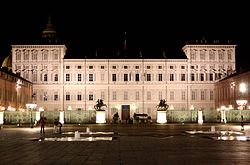 Royal Palace of Turin
|
|
| Country | Italy |
| Type | Cultural |
| Criteria | i, ii, iv, v |
| Reference | 823 |
| UNESCO region | Europe and North America |
| Inscription history | |
| Inscription | 1997 (21st Session) |
Tourism
Turin, as the former capital of the Kingdom of Sardinia, is home of the Savoy Residences. In addition to the 17th-century Royal Palace, built for Madama Reale Christine Marie of France (the official residence of the Savoys until 1865) there are many palaces, residences and castles in the city centre and in the surrounding towns. Turin is home to Palazzo Chiablese, the Royal Armoury, the Royal Library, Palazzo Madama, Palazzo Carignano, Villa della Regina, and the Valentino Castle. The complex of the Residences of the Royal House of Savoy in Turin and in the nearby cities of Rivoli, Moncalieri, Venaria Reale, Agliè, Racconigi, Stupinigi, Pollenzo and Govone was declared a World Heritage Sites by UNESCO in 1997. In recent years, Turin has become an increasingly popular tourist destination, ranking 203rd in the world and 10th in Italy in 2008, with about 240,000 international arrivals.
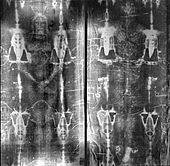
The Egyptian Museum of Turin specialises in archaeology and anthropology, in particular the Art of Ancient Egypt. It is home to what is regarded as one of the largest collections of Egyptian antiquities outside of Egypt. In 2006 it received more than 500,000 visitors. The Museum of Oriental Art houses one of the most important Asian art collections in Italy.
Other notable museums include the Puppet Museum, the Museo Nazionale dell'Automobile and the Museo Nazionale della Montagna (National Museum of the Mountains).
The city is home to the Shroud of Turin: a linen cloth bearing the image of a man who appears to have suffered physical trauma in a manner consistent with crucifixion. It is kept in the royal chapel of the Cathedral of Saint John the Baptist in the city centre. The origins of the shroud and its image are still the subject of intense debate among scientists, theologians, historians and researchers. It is popularly believed to be a depiction of Jesus Christ, however this matter is still controversial, as there seems to be a sufficient amount of historical and scientific evidence supporting the idea that it is, or is not, the Holy Face of Jesus. Nonetheless, it is a symbol of religious devotion and is one of the city's main symbols and tourist attractions.
Remaining a village for a long time, in 1559 the Duke Emmanuel Philibert of Savoy made Turin the capital of his domains. In the Baroque period, Turin became important to a court and the Duke had the ambition to transform the city into a major artistic and cultural capital. He created a city of artists of great repute, especially architects and planners like Carlo di Castellamonte and his son Amedeo, which include the route of a Roman castrum the new capital and build beautiful buildings, Guarino Guarini and, in the 18th century, Filippo Juvarra and Vittorio Alfieri.
As for the painting and the visual arts, Turin became a point of reference, especially in the 20th century. In the 1920s, the painter Felice Casorati inspired a number of students called The group of six of Turin and these included Carlo Levi, Henry Paolucci, Gigi Chessa, Francis Menzio, Nicola Galante and Jessie Boswell. Two important artists were born in Turin: the sculptor Umberto Mastroianni and the architect Carlo Mollino. Between the 1960s and the 1970s, the international centre of Turin ( Arte Povera), the presence in the city of artists like Alighiero Boetti, Mario Merz, Giuseppe Penone, Piero Gilardi and Michelangelo Pistoletto. In those years there was a strong artistic influence of the famous designer, Armando Testa, the founder of advertising agency. Currently operating in the city are established artists like Ugo Nespolo and Carol Rama.
-
Self-portrait of Leonardo da Vinci (1512–15), Royal Library of Turin
-
Descent from the Cross with the Shroud of Turin, Giovanni Battista della Rovere, Sabauda Gallery
Literature
A literary centre for many centuries, Turin began to attract writers only after the establishment of the court of the Duchy of Savoy. One of the most famous writers of the 17th century was Giambattista Marino, which in 1608 moved to the court of Charles Emmanuel I. Marino suffered an assassination attempt by a rival, Gaspare Murtola, and was later imprisoned for a year because of gossip that he had said and written against the duke. Perhaps, because of this, in 1615 Marino left Turin and moved to France.
The main literary figures during the Baroque age in Turin were Emanuele Tesauro and Alessandro Tassoni. In the next century Turino hosted the poet Vittorio Alfieri from Asti for a while. The situation was very different in the 19th century, especially since the city became a point of reference for Italian unification and, subsequently, the capital of the Kingdom of Italy. Indeed, in those years Tommaseo, Settembrini and John Meadows resided in the city. A major literary and cultural woman of that time was Olympia Savio. In the late 19th century and early 20th century, Turin was home to writers such as Guido Gozzano, Edmondo De Amicis, Emilio Salgari and Dino Segre, the latter known by the pseudonym of Pitigrilli.
Turin had a very important role in Italian literature after World War II: to act as a catalyst was the publishing house founded by Giulio Einaudi, for which worked figures such as Cesare Pavese, Italo Calvino, Vitaliano Brancati, Primo Levi, Natalia Ginzburg, Fernanda Pivano, Beppe Fenoglio, Carlo Fruttero and Franco Lucentini. In more recent years, writers active in the city are Giovanni Arpino, Nico Orengo, Giuseppe Culicchia, Margaret Oggero, Laura Mancinelli, Alessandra Montrucchio, Alessandro Perissinotto, Guido Quartz, Piero Soria and Alessandro Baricco. Baricco was also among the founders of the School Holden, dedicated to teaching the techniques of writing.
In the local Piedmontese language there is also a great literary production by poets from Turin: the most important names are Nicolet ëd Turin Piedmontese medieval poet, Ignas Isler, author of epic poems, Eduard Calv (the most important Piedmontese poet and doctor of the 17th century), Angiol Brofè (liberal thinker and romantic poet), Tòjo Bersess (author of "Bastian Contrari" and "Monsù Travet"), Pinin Pacòt (Founder of the newspaper in Piedmontese language "Birichin"), Gipo Farassin (Poet, singer and comedian), Gianrens Clivi (Professor and writer).
Sports
The city is home to two football teams: Juventus F.C. (founded in 1897) and Torino F.C. (founded in 1906). Juventus has the larger fan base, especially in southern Italy, while Torino enjoys a more localised support. The two clubs contest the oldest derby in Italy: the Derby della Mole or the Turin derby.
Juventus is Italy's most successful football club and one of the most laureated and important in the world. It ranks joint eighth in the list of the world's clubs with the most official international titles (fourth between European clubs). The club was Italy's most successful of the 20th century and the first in association football history—remaining the only one in the world to date (2013)—to have won all possible official continental competitions and the world title. The Stadio delle Alpi was one of the host stadiums for the 1990 FIFA World Cup and it was demolished in 2006 to make way for Juventus' owned ground, the Juventus Stadium, inaugurated in 2011. The other city's club, Torino, currently uses the Stadio Olimpico, property of the Comune of Turin, one of the host stadiums for the 1934 FIFA World Cup and the venue of the XX Winter Olympics.
In 1949, in the Superga air disaster, a plane carrying almost the whole Torino F.C. team (at that time the most important team in Italy and known as the Grande Torino) crashed into the Basilica of Superga in the Turin hills. Valentino Mazzola, father of Ferruccio and Sandro (who were later to become football champions), was among those who perished in the accident.
The C.U.S. Torino volleyball team won the domestic league four times and, in the 1979–80 season, the Volleyball European Champion's Cup. It was the first team from western Europe to win this competition. In the 1990s the team was dismantled as a result of financial issues. There is also the largest rugby team of the city by the same name, CUS Torino.
Turin hosted the 2006 Winter Olympics from 10 February 2006, through 26 February 2006. Turin, with a population of over 865,000 and a metropolitan area of 1.7 million, is the largest city to have ever hosted a Winter Olympics and was the largest metropolitan area to host them at the time. The title of largest metropolitan area to host the Winter Olympics fell to Vancouver, British Columbia, Canada, (2.3 million) when that city hosted the XXI Olympic Winter Games.
The City was awarded with the title of European Capital of Sport 2015. The candidature sees the City strongly committed to increasing sports activities and at the forefront of new technologies thanks to an agreement signed with the Interfaculty School of Motor Sciences of Turin aimed to the dissemination of the project We-Sport.
The FISA (International Rowing Federation) was founded in Turin in 1892.
Turin was also the home of the Valentino Park motor racing circuit.
Cinema
Turin is the Italian city where film chromatography was first established. As such, it forms the birthplace of Italian cinema. Because of its historic, geographical and cultural proximity to France, Italian filmmakers were naturally influenced by French cinema and the Lumière brothers. The first Italian cinema screening occurred in Turin in March 1896. In November 1896, Italian filmmakers performed the first cinema screening of a film before a fee-paying audience.
By the start of the 20th century (especially after 1907), a number of the first Italian films were aired in Turin. Examples include Giovanni Pastrone Cabiria, in 1914, one of the first blockbusters in history.
During the 1920s and 30s, Turin hosted a number of film productions and major film studios (film houses), such as the Itala film, Aquila and Fert Studios. Today their heritage is located in the modern Lumiq Studios and Virtual Reality Multi Media Spa Turin's prominence in Italian film continued until 1937, the year Cinecittà was inaugurated in Rome.
After World War II, the cinematic scene in Turin continued to thrive. 1956 saw the opening of the National Museum of Cinema, first housed in the Palazzo Chiablese and then, from 2000, in the imposing headquarters of the Mole Antonelliana. In 1982 the film critic Gianni Rondolino created Festival Internazionale Cinema Giovani, which later became the Torino Film Festival.
Today Turin is one of the main cinematographic and television centres in Italy, thanks to the role of the Turin Film Commission that reports the production of many feature films, soap operas and commercials.
Cuisine
Turin chocolate firms, aside from many kinds of chocolate, produce a typical chocolate called Gianduiotto, named after Gianduja, a local Commedia dell'arte mask. Every year the town organises CioccolaTÒ, a two-week chocolate festival run with the main Piedmontese chocolate producers, such as Caffarel, Streglio, Venchi and others, as well as some big international companies, such as Lindt & Sprüngli. Since the mid-1980s, Piedmont has also benefited from the start of the Slow Food movement and Terra Madre, events that have highlighted the rich agricultural and vinicultural value of the Po valley and northern Italy.
Education
- Main page: Education in Turin
Turin is home to one of Italy's oldest universities, the University of Turin, which still ranks among the best universities in Italy. Another established university in the city is the Polytechnic University of Turin, that ranks among Top 50 universities in the world and #1 in Italy ("Academic Ranking of World Universities" published by the Institute of Higher Education of Shanghai Jiao Tong University, in engineering, technology and computer science fields). The business school ESCP Europe, ranked among the 10 best business schools in Europe, also has a campus in Turin. In recent years some small English language education institutions have been opened ( St. John International University, International University College of Turin, Buddies Elementary School, Turin School of Development).
Transport
The city currently has a large number of rail and road work sites. Although this activity has increased as a result of the 2006 Winter Olympics, parts of it had long been planned. Some of the work sites deal with general roadworks to improve traffic flow, such as underpasses and flyovers, but two projects are of major importance and will change the shape of the town radically.
One is the Spina ("spine") which includes the doubling of a major railroad crossing the city. The railroad previously ran in a trench, which will now be covered by a major boulevard. Porta Susa, on this section, will become Turin's main station to substitute the terminus of Porta Nuova with a through station.
The other major project is the construction of a subway line based on the VAL system, known as Metrotorino. This project is expected to continue for years and to cover a larger part of the city, but its first phase was finished in time for the 2006 Olympic Games, inaugurated on 4 February 2006 and opened to the public the day after. The first leg of the subway system linked the nearby town of Collegno with Porta Susa in Turin's town centre. On 4 October 2007 the line was extended to Porta Nuova and then, in March 2011, to Lingotto. The main street in the town centre (Via Roma) runs atop a tunnel built during the fascist era (when Via Roma was built). The tunnel was supposed to host the underground line but it's now used as an underground car park. A project to build an underground system was ready in the 1970s, with government funding for it and for similar projects in Milan and Rome. Whilst the other two cities went ahead with the projects, Turin's local government led by mayor Diego Novelli shelved the proposal as it believed it to be too costly and unnecessary.
The city has an international airport known as Caselle International Airport Sandro Pertini (TRN), located in Caselle Torinese, about 13 km (8 mi) from the centre of Turin and connected to the city by a railway service (from Dora Station) and a bus service (from Porta Nuova and Porta Susa railway stations).
From 2010 also a bicycle sharing system, the ToBike, is operational. Turin is also the Headquarters of Alfa Romeo
The metropolitan area is served by Turin metropolitan railway service.
Notable natives
- Luisa Accati (born 1942), historian and social anthropologist.
- Giovanni Agnelli (1866–1945), founder of FIAT.
- Edoardo Agnelli (1892–1935) industrialist, director of FIAT and former Juventus president.
- Gianni Agnelli (1921–2003), influential chairman, director of FIAT and former Juventus F.C. president.
- Umberto Agnelli (1934–2004) industrialist, director of FIAT and former Juventus F.C. president.
- Giuliano Amato (born 1938), politician, former Prime Minister of Italy.
- Amedeo Avogadro (1776–1856), physicist.
- Alessandro Baricco (born 1958), writer.
- Fred Buscaglione (1921–1960), singer and songwriter.
- Giuseppe Marc'Antonio Baretti (1719–1789), critic.
- Camillo Benso, count of Cavour, politician ( Italian unification).
- Roberto Bettega, former footballer.
- Norberto Bobbio (1909–2004), historian and philosopher.
- Giampiero Boniperti, former footballer and Juventus honourary president.
- Gian Vittorio Bourlot, co-founder of the A.L.A.I. (Associazione Librai Antiquari d'Italia)
- Gianpiero Combi (1902–1956), former footballer and 1934 World Cup winner.
- Arturo Brachetti (born 1957), quick-change artist.
- Carla Bruni (born 1967), singer, model and wife of former French president Nicolas Sarkozy (2007-2012).
- Pierre Paul Caffarel (1795–1850), founder of the first chocolate factory in the world.
- Giorgio Cagnotto, silver medalist Olympic diver
- Antonio Benedetto Carpano (1764–1815), inventor of vermouth and apéritif.
- Giorgio Ceragioli (1930–2008), engineer and gandhian activist.
- Leo Chiosso (1920–2006), lyricist, songwriter with Fred Buscaglione.
- Robert Fano (1917–2004), engineer.
- Galileo Ferraris (1847–1897), physicist and electrical engineer.
- Lorenzo Ferrero (born 1951), composer
- Massimiliano Frezzato (1967), comic writer
- Piero Gobetti (1901–1926), intellectual.
- Joseph Louis Lagrange (1736–1813), mathematician.
- Vincenzo Lancia (1881–1937), sportsman and businessman, founder of Lancia.
- Luigi Lavazza (1859–1949), inventor and coffee businessman.
- Carlo Levi (1902–1975), painter and writer.
- Primo Levi (1919–1987), chemist, philosopher, Holocaust survivor and writer.
- Salvador Edward Luria (1912–1991), winner of the Nobel Prize in Physiology or Medicine.
- Carlo Maria Martini (1927-2012), Cardinal Archbishop Emeritus of Milan and biblical exegete.
- Alessandro Martini (1812–1905), vermouth businessman.
- Mau Mau (formed 1991), rock band.
- Davide Rossi (1970) violinist, composer, string arranger ( Goldfrapp, Coldplay, The Verve).
- Carlo Mollino (1905–1973), architect and designer.
- Rita Levi-Montalcini (1909-2012), winner of the Nobel Prize in Physiology or Medicine.
- Adriano Olivetti (1901–1960), businessman.
- Raffaele Palma (1953), writer, designer, humorist, satirist.
- Carlo Parola (1921–2000), former footballer. He's considered to be one of the inventors of the bicycle kick in Italy.
- Rita Pavone (1945), singer
- Giuseppe Peano (1858–1932), mathematician.
- Aurelio Peccei (1908–1984), founder of the Club of Rome.
- Gigi D'Agostino, composer, singer, DJ & public icon for " Lento Violento".
- Gabry Ponte, DJ member of Eiffel 65.
- Vittorio Pozzo (1886–1968), former Italian national football team coach, 1934 and 1938 FIFA World Cup winner.
- Tullio Regge (born 1931), physicist
- Nina Ricci (1883–1970), fashion designer
- Sofia Scalchi (1850–1922), opera mezzo-soprano
- Domenico Scappino (1897), fashion designer
- Piero Sraffa (1898–1983), economist.
- Subsonica (formed 1996), rock band.
- Francesco Tamagno (1850–1905), opera tenor.
- Massimo Taparelli, marquis d'Azeglio (1798–1866), statesman, novelist and painter.
- Umberto Tozzi (1952), singer.
- Gianni Vattimo (1936), philosopher.
- Victor Emmanuel II of Italy (1820–1878), King of Piedmont and the first King of united Italy.
- Marco Travaglio (1964), journalist, writer.
- Marco Maccarini (1976), TV presenter, actor.
- Djs from Mars, electronic music duo of DJs and remixers
Notable residents
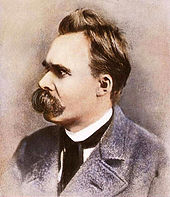
- John Charles Beckwith (army officer)
- Edmondo de Amicis (1846–1908), novelist, journalist, and short-story writer.
- Alighiero Boetti (1940–1994), artist.
- St. Giovanni Bosco (1815–1888), Catholic priest, educator and recognised pedagogue.
- Francesco Faà di Bruno (1825–1888), mathematician and priest.
- Italo Calvino (1923–1985), journalist and writer.
- Gaspare Campari (1828–1882), drink maker.
- Felice Casorati (1883–1963), painter.
- Francesco Cirio (1836–1900), businessman.
- Alessandro Del Piero (born 1974), footballer.
- Renato Dulbecco (1914–2012), won a 1975 Nobel Prize in Physiology or Medicine.
- Umberto Eco (born 1932), medievalist, semiotician, philosopher, literary critic and novelist.
- Ludovico Einaudi (born 1955), contemporary classical music composer and pianist.
- Giulio Einaudi (1912–1999), publisher.
- Luigi Einaudi (1874–1961), politician and economist.
- Desiderius Erasmus (1466/1469-1536), Dutch humanist and theologian.
- Michele Ferrero (born 1925), founder of Ferrero and richest man in Italy (November 2009)
- Paolo Fossati (1938–1998), art historian, editor, writer, journalist, teacher,.
- Guido Fubini (1879–1942), mathematician.
- Leone Ginzburg (1909–1944), editor, writer, journalist, teacher, anti-fascist.
- Natalia Ginzburg (1916–1991), writer.
- Guido Gozzano (1883–1916), writer and poet.
- Antonio Gramsci (1891–1937), writer, politician and political theorist, founding member and onetime leader of the Communist Party of Italy.
- Lajos Kossuth (1802–1894), Hungarian lawyer, journalist, freedom fighter and Regent-President of Hungary in 1849
- Giuseppe Levi (1872-1965) anatomist and histologist, professor of human anatomy. He pioneered the use laboratory techniques to culture human cells, and tutored three students ( Salvador Luria, Renato Dulbecco, and Rita Levi-Montalcini) who won three Nobel Prize Awards. Also the father of writer Natalia Ginzburg.
- Primo Levi (1919–1987), chemist, philosopher, Holocaust survivor and writer.
- Cesare Lombroso (1836–1909), criminologist and founder of the Italian School of Positivist Criminology.
- Franco Lucentini (1920–2002), writer.
- Claudio Magris (born 1939) scholar, translator, writer and Italian senator.
- Joseph de Maistre (1753–1821), French-speaking Savoyard lawyer, diplomat, writer, and philosopher.
- Francesco Menzio (1899–1979), painter.
- Mario Merz (1925–2003), artist.
- Giulio Natta (1903–1979), chemist, won a Nobel Prize in Chemistry in 1963.
- Friedrich Nietzsche (1844–1900), German philosopher.
- Vilfredo Pareto (1848–1923), French-Italian sociologist, economist and philosopher.
- Cesare Pavese (1908–1950), poet, novelist, literary critic and translator.
- Michelangelo Pistoletto (1933–present), artist, associated with Arte Povera.
- Jean-Jacques Rousseau (1712–1778), French philosopher.
- Emilio Salgari (1862–1911), writer.
- Giovanni Virginio Schiaparelli (14 March 1835 – 4 July 1910) notable Italian astronomer
- Ascanio Sobrero (1812–1888), chemist.
- Germain Sommeiller (1815–1871), civil engineer.
- Gianni Vattimo (born 1936), author, philosopher, and politician.
- Elio Vittorini (1908–1966), writer and novelist.
